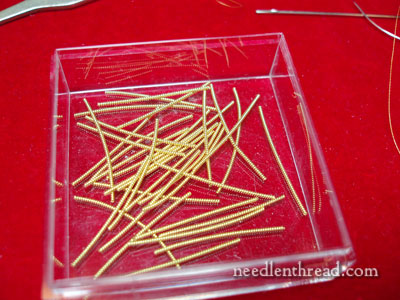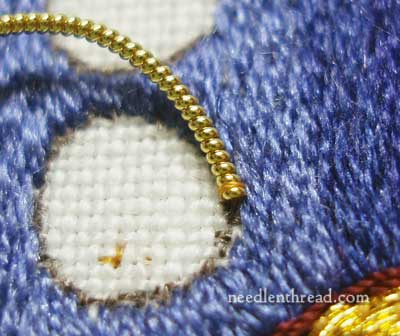The little goldwork dots in the outside edge of the Medallion are under way again. There are 50 of these little dots in the edge, and they’re worked in a combination of pearl purl (for the outline) and chips (little cuts of check purl) for the filling.
If there weren’t 50 of these dots to contend with, I’d say they weren’t too time consuming. The dots are about 5/16″ – 3/8″ in diameter, so they’re pretty small. This makes manipulating the pearl purl (which is a stiff thread) somewhat slightly less than fun. Actually, every time I finish a dot, I find myself saying, “Bah – that wasn’t so bad!” and I move on to the next fiddly little blighter with an ever-increasing excitement at being one step closer to the end.
Today, I’ll show you how I work the pearl purl outlines and talk a little bit about working with this versatile and beautiful real metal thread.

These are some of the rings, unfilled. You can see the join in them where the two ends of the thread come together, and in fact, these are two of the better joins. Right now, it’s just a matter of getting the pearl purl couched on in the ring shape, and when I go back to put in the chips, I’ll nudge the pearl purl about a bit to smooth up the joins.

Since I’m working in bulk here, it’s easier to pre-cut the necessary lengths of pearl purl. For the dots, I need less than one inch of pearl purl, but I cut 20 one-inch pieces of pearl purl to work with. It’s always better to have a piece that’s slightly longer than needed rather than too short.
Before cutting the pearl purl, I pre-stretched the whole length, by running it through my fingers and barely stretching it a bit. This serves to separate the coils slightly (not enough to really be noticed by the eye) and also to take the “boing” out of the length of pearl purl. If you ever have an opportunity to work with this thread, you’ll find that, in a long length, it tends to be rather springy and boingy, until you give it a slight stretch. The stretch stiffens it up a bit and makes it easier to work with.

Before couching the pearl purl onto the design, I wound it around the handle of my laying tool, to put some curve in it. After couching several of these, I discovered it’s easier to couch them into a smooth circle if they already have some bend in them. Winding a one-inch piece around the narrow round handle of a tool puts enough bend into the piece to make it easier to manipulate into a tight little ring.

It’s necessary to choose a couching thread that corresponds somewhat to the size of the pearl purl you’re couching. If you’re couching a #3 pearl purl – a very large pearl purl – you can get away with a fairly heavy couching thread. But for the rings, I’m using size “very fine,” which is (you guessed it!) very fine. So the couching thread has to be very fine as well – it has to fit down in between those coils without leaving a noticeable gap. For a couching thread, I’m using a 100 wt. silk sewing thread by YLI. Before stitching, the thread has to be well-coated with beeswax, so I run it through my wax cake about three or four times, and then slowly through my fingers to blend the wax in and remove any excess bits that are hanging about.
I start the couching thread by anchoring it in the middle of the dot using three or four tiny stab stitches. Then I bring the thread up on my outline where I want to start the pearl purl, and then take it back down on the the outline, pulling through until I have a small loop, which can be seen in the photo above.

The length of pearl purl is inserted into the loop, and I slowly pull the couching thread until it is tight around the pearl purl, in the place I want it, which is right between the first and second coil.

In the photo above, you can see the couching thread hugging the pearl purl, right between the first and second coil. Once the couching thread is in place between the correct coils, I give it a little tug, and it pops down between the coils, so that it is invisible.

Couching between every two or three coils, I work my way around the little circle, and as I get towards the end, I snip off any excess pearl purl, so that the two ends can butt up next to each other. The last couching stitch is taken right before the last gold coil, and then out comes the mellor and the tweezers, to smooth up the gold thread and put the ends in place.
I’ll be ringing away the rest of today, and probably tomorrow, too! With all this ringing going on, you might be tempted to think the roses are finished. In fact, they aren’t. They are almost finished – 1.5 to go – but I needed a rose break, and I also wanted to gauge how long the dots would take. So that’s where I am this morning! By the end of the week (or early next week), I should have some overall progress shots to show you.
If you would like to read the back story of this project and follow it along from its beginnings (in the design stages) up to now, you can find all the articles relating to the Medallion project listed in chronological order in the Medallion Project Index. Throughout the series, you’ll not only see the project develop step-by-step, but you’ll also find plenty of tips and techniques that you can apply to your own needlework projects.
If you’d like access to all the tips and techniques discussed in the Medallion Project, including complete step-by-step coverage of the Tudor-Style Rose, conveniently collected in one document, interlinked, referenced, and indexed, why not add the Marian Medallion Project e-book to your library? It’s packed full of all kinds of embroidery tips for undertaking a project like this, all in a convenient electronic format for easy searching.







I can’t tell you how glad I was to read this post and actually see “how” to do the pearl around the edge of the dots! It’s like having a master teacher right there explaining every step. Thank you!
G’day Mary,
The patient progress.
Yes, a couple of sentences in one but each appropriate.
Good on you Mary. Cheers, Kath.
It’s looking great, as always, but Mary, I can’t tell you how comforting it is that even YOU don’t always get an absolutely 100% perfect invisible join with pearl purl! I have been struggling with some silver-plate pearl purl lately and the joining is really tricky!
You are so encouraging! You are in the midst of this endurance challenge and you are just steady. I love how you change things up to go on (switching to rings around the rosies)! When you look back at all that you have done so far, from concept to transfer to set-up to stitching it’s amazing to see how close you are to finishing! WOOOHOOO!!!! Keep on keeping on!!!
I don’t know how you do this type of work. I’d be fretting every moment that my couching thread would break from all that stress of tugging and popping it through each bit of coil.
And I’d love to see how you couch almost all of it and still manage to clip the gold to the proper length when you have so little to work with. I’d be worried I’d clip just a little too much or a coil too long. Or. . . .clip some threads nearby.
I can see this goldwork is not for the faint of heart. I’m thankful for people like you that can do this and share all the pretties with us.
I’ve worked with pearl purl before, but never thought of ‘pre-curling’ it. That’s a good idea and I’ll use it next time I work with this thread. It’s always scary to me to trim the end to length. I don’t like putting my scissors that close to my work.
Such beautiful thread to work with, and such a good job you do. Love the step-by-step pictures — it brings your good descriptions to life.
I am waiting here with bated breath hoping you finish on time. Who knew “watching” someone else stitching a project could be so exciting. You are a talented photographer and writer as well as stitching artist. Amazing aptly described you.
Aloha Mary,
Beautiful joins. Love the pre-curling hint. I hope you have good music on while doing the dots. Funny but if you don’t think about “how many” it is amazing “how many” you get done. Aren’t you happy you don’t do Italian mosaics? lol
Ji
This really looks like an intense process. I would definitely need a Margarita after finishing those.
As I have sat and read your concise description of the processes involved in couching the purl purl alongside the helpful photographs, it has made me realise how long it has been since I had a piece of goldwork to complete and how much I miss it. Don’t forget to take a deep breath, relax your shoulders and look away from the work as you finish each one! Happy sewing…